
|   |

|   |
 e-mail: leelakaverivenkat@gmail.com Week of varied fare May 19, 2024 The evening of Odissi dance at the Triveni was titled Sankalan. Conceived by Odissi dancer and teacher Anita Babu trained under late Gangadhar Pradhan at Orissa Dance Academy of Bhubaneswar, Sankalan presented the results of a four day workshop conducted by the present head of Orissa Dance Academy (who also happens to be the President of the Odisha SNA) namely Guru Aruna Mohanty, one of the senior-most of Guru Gangadhar's students. Held at Anita Babu's institution Odissi Natya Sala initiated in 1999 in Delhi with her late Guru as co-founder, the event brought together students of several Odissi strains trained under various teachers - from Madhavi Mudgal to Vani Madhav, Alpana Nayak, Lipsa Satpathy, Bimal Pradhan, Garima Hazarika, Sudarshan Misra, Sahoo and Prapti Gupta. As to be expected, with students of so many teachers participating, one could see within the disciplined unity in the group presentations, designed by Guru Aruna Mohanty, performers in the minutiae of movement, reflecting the impact of different gurus. The Shankarabharanam Pallavi in a group arrangement conceived by Aruna, presenting a large group with eleven participants, for this critic, again showed how this item with Guru Kelucharan's choreography and Bhubaneswar Mishra's music, has become synonymous with Odissi dance, its impact never dwindling with repetition. 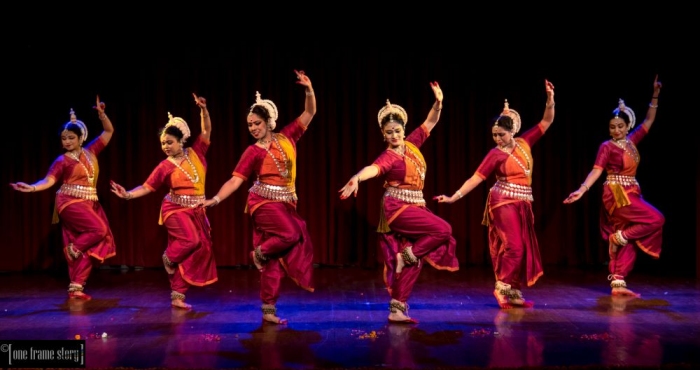 That seriously conducted workshops can yield dividends in terms of enhanced understanding of certain aspects of the dance is proven. Aruna Mohanty, in a passing statement from the stage between items, revealed how challenging it was to pass on an understanding of an item like an ashtapadi in four days, to a motley group of students. All the participants came together in the interpretative item based on an Oriya composition Bansi swara, extolling the dhwani and supreme melody of Krishna's flute, with earth seeming to come to a standstill, holding man and nature enthralled. Based on music composed by Gopal Chandra Panda, with Bijay Barik providing the rhythmic output, Aruna's choreography with scope for imitating the gait of all nature's creatures starting from the leaping deer, the peacock, the tiger et al saw dancers reveling in the movements. Aruna herself presented the ashtapadi Ramate Yamuna pulinavane, depicting love struck Radha setting forth to join Krishna on a sandbank of the Jamuna, retreating in anguish on seeing him exchanging love's intimacies with another woman. With her special gift for abhinaya, Aruna's rendition of this Jayadeva composition based on the music of A.Subhas Pani, with rhythmic inputs by Bijay Barik, carried intensity in restraint, much needed in an interpretation of this poetry of Jayadeva. 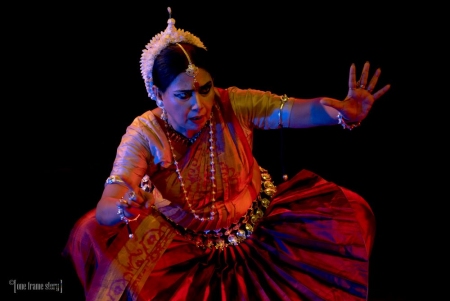 Aruna Mohanty Kedar Misra and Aruna Mohanty as a twosome, with his providing a researched script on the basis of which she composes her dance, have created many a new work - the sense of theatre in his scripts providing an avenue for the dancer's desire to explore new dramatic territory through the Odissi idiom. Based on the Mahabharatha character Ashwathama, son of Dronacharya, the archery Guru of the Pandava and Kaurava princes, who is chaffing under the restriction of a fine archer like himself, not being allowed to show his mettle in the Kurukshetra war - merely on account of his being a Brahman, since the battle field is the place for the Kshatriyas. But watching the dwindling Kaurava hegemony in the war, Duryodhana the head, knowing Ashwathama's desires, enters into a secret understanding with him, for entering the Pandava camp undetected in the darkness of night, and killing the Pandava brothers. The elated Ashwathama, however, in the dead of night, mistaking the five sleeping figures as the Pandava princes, cuts off instead, the heads of the young sons of the Pandavas. Having incurred the wrath of both father Drona and Duryodhana for messing up the plot, Ashwathama is cursed by Krishna as the eternal outcaste, whom even death will not accept. After a quick recap of earlier action, the dance work is mainly built round Ashwathama's anguish Mukti diyo mote - mage mrityu....in pleading for death, which has closed its doors to him. With music composition by Ramahari Das, and rhythmic inputs by Dhaneswar Swain, Aruna uses her interpretative skill in bringing out the undying anguish of Ashwathama through contained abhinaya, saving the item from becoming pure dance theatre. Dancers in inviting on to the stage colleagues in the audience, to present tokens of appreciation, is certainly one way of promoting a feeling of oneness amongst the dance community. But the sheer scale of dupattas presented, certainly makes a further dent in pockets of those organizing, and dancers, by no means an over compensated lot for their activities, can do, one feels, without this goodwill gesture, by just mentioning the names of those present and expressing a thank you. SMALL AUDIENCE IN LARGE HALL CHARMED BY ANJU CHANDRAN'S BHARATANATYAM It was a pitifully scanty gathering in the Stein auditorium, for the Bharatanatyam performance of Anju Chandran of the Chennai Kalakshetra alumni. But what heart warming applause after each item! It did not take long for the audience to understand that here was a dancer totally unaware of herself and utterly charming - the line perfect nritta, and restrained poise of the abhinaya, never attracting attention to the persona of the dance. The underplayed aesthetics in costume and get up with every fold of the fan in place, was a delight to behold. Dancing to recorded accompaniment, after commencing with Alarippu in khandatriputa, performed to music in Kalyani, the dancer went on to the centerpiece, a Padavarnam in Sreeranjani, with the jati punctuations set by Seetharama Sharma. "Swamy nee manam irangi arul ta ma" pleads the Nayika of Lord Muruga, that he take pity on one lost in thoughts of the Lord, and arrive on his vahana, the peacock, to accord her a darshan. Wilting away in separation, believing only in the Lord, she single mindedly awaits his arrival. 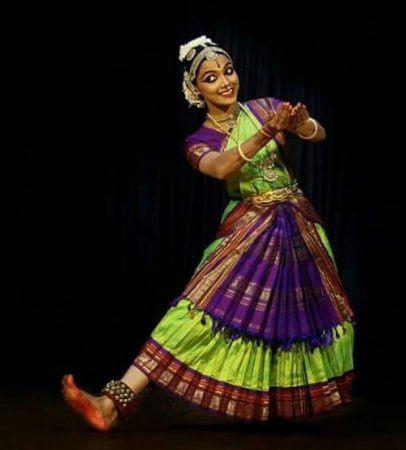 Anju Chandran The quality of restraint was underlined even in the execution of the jatis. The overplayed long leg stretches, wide sweeping gestures and ways of trying to cover the ample stage space by a solo dancer, a frequent scene today, were all missing. Anju confined herself to the centre of the stage, and the entire dance had not a hint of trying to impress an audience. That the audience appreciated the completely involved dancing with no attention drawn to the dancer, was, for this critic, a sign of maturity. The pure abhinaya section in the post varnam session saw two compositions, the first Thunga tarange Gange Jaya in Hamsadhwani, a composition of Sadashiva Brahmendra, a 15th/16th century saint composer, totally in the bhakti mode, a homage to river Ganga, perched in the locks of Shiva and whose waters flowing on earth provide succor to countless people. The next pinned on the sringar element, has the nayika rebuking Manmatha for constantly hustling her with his arrows of love, in her solitary state. Madappayale mannan varattum (Senseless fellow, let my lover come and you will not be spared for your mischief) says the nayika. Set to music in Paras by Subbarama Iyer, the dance visualization is by Bragha Bessel. The scrupulously neat and self-contained finale of a Tillana in Hindolam set to Khanda ekam, with a concluding homage to Goddess Kamakshi, was followed by very enthusiastic applause from the audience - leaving a feeling of a very small discerning audience being preferable to a larger group unable to enjoy the finer aspects of the recital. NATYA TARANGINI'S TWENTY EIGHTH YEAR OF TEACHING KUCHIPUDI In a fast changing world, passing on to the next generation of students the essence of an art form inherited as a legacy from past gurus, faces greater challenges - on how to keep the roots of the art alive, while adapting to a contemporary clientele of both students and audience. As usual the evening at Natya Tarangini's outdoor performance space with galleried seating, began with the wise words of Raja Reddy on prachisudha and bhinnaruchi and on keeping in mind while teaching the responsibilities in passing on the cardinal principles of the oldest living civilization, namely India. 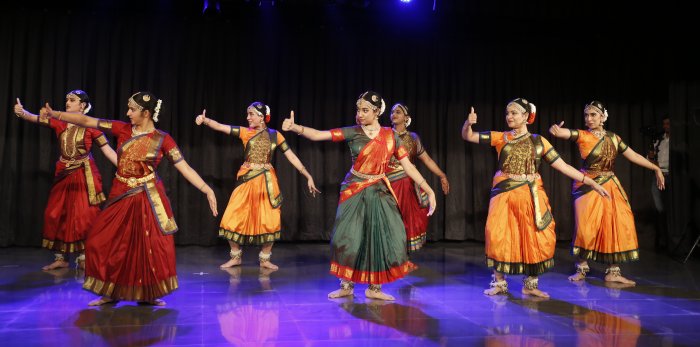 Ganapati Vandana 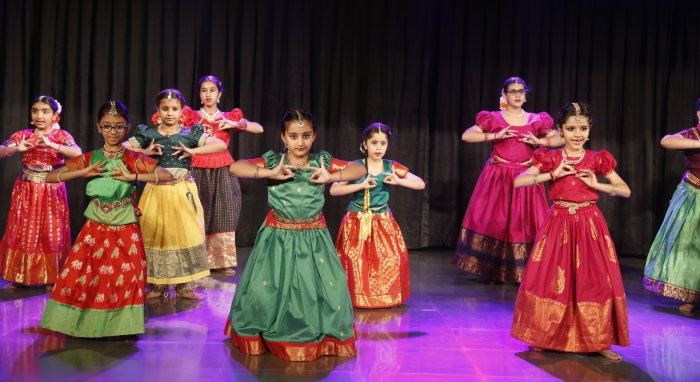 My heart is a temple Predictably, the programme began with the prayer to Ganapati Gana Nathaya Namaste in raga Gaula set to adi talam. Satyam, Shivam, Sundaram being the cardinal principles of India's civilizational ethos, the teaching of young beginners in an original way, has tried to blend students from different faiths learning the dance, in an exercise wherein the dance emphasizes the spiritual nature of the art form, coupled with a choreographed enterprise showing respect for all religions. Starting with "Lord, make my heart as a temple" to "my heart is a temple" with a prayer to Jesus, Allah, Krishna and Rama, interspersed with "Dhit dhit thai, Ta dhimi hat tat tha" nritta punctuations after the sahitya lines, here was an attempt at combining dance with devotion, with morality, with beauty and with the nritta bits aping the animal gaits - a part which was greatly relished. The main point for this critic was that the youngsters enjoyed the experience and even when the odd ankle bell strand threatened to come loose, the little ones had the sangfroid to continue without showing obvious discomfort. To single out exceptional dance prowess in the midst of groups of students participating, would be incorrect. Suffice it to say, that amidst the varying abilities, what stood out was the group discipline. The Shabdam in Kuchipudi takes many forms, built round different themes. As a narrative it encloses a great dramatic element. The first shabdam was built round the theological Gajendra moksham episode, wherein elephant Gajendra while drinking water, having his leg caught in the jaws of a crocodile, prays to the Lord, to be finally saved by Vishnu's disc destroying the marauder. This was followed by Rajeshri Shabdam by Veera Bhadraiyya of early 17th century in Ragamalika form. Addressed to King Pratapa Simha, this embodies what is known as Salaam Jatis, with the dancer in court saluting royalty. It was interesting watching student Padma Qureshi getting involved in presenting "Bhamane Satyabhamane" wherein vain glorious Satyabhama, the darling heroine of Kuchipudi, makes an entry announcing herself as the most beautiful and coveted of the queens of Krishna. What was traditionally confined to the dancer from the Andhra region, in the contemporary situation, while attracting numerous performers from areas outside of the Telugu region, acquires new sensibilities, flowing from the cultural background of the dancer. 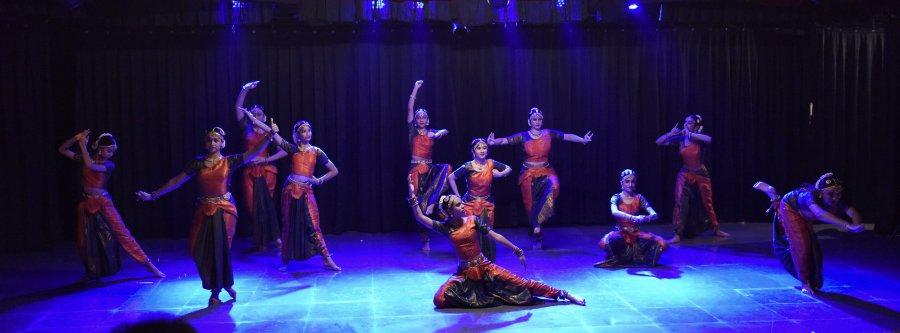 Dasavataram 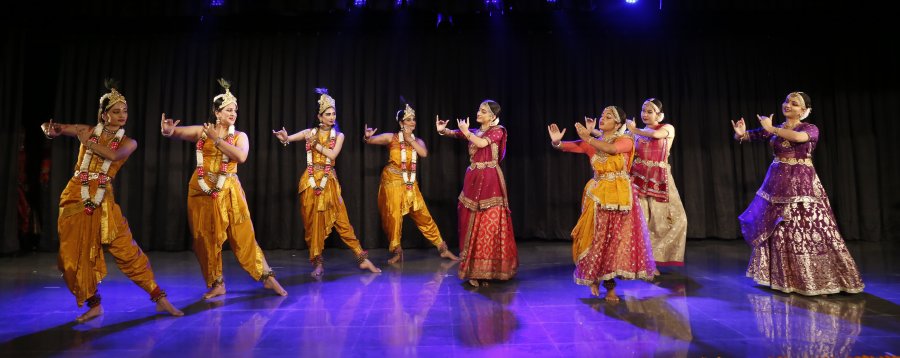 Ashtapadi The Jayadeva ashtapadi "Rase hari miha vilita vilasam" in raga Mohanam, as choreographed was somewhat confusing. The poetry shows a crestfallen Radha, on seeing Hari playing Raas with several gopis. Lines like vipula pulakita pallava... are a description of Krishna's arms like vines twirled round several gopis. The way it was presented showing several Krishnas with Gopis playing Raas, was a little intriguing. The Raas in this ashtapadi is just Hari sporting with several gopis. The finale of Tarangam with the plate dance was executed with joy. It was heartening to see how parents and guardians of students had turned up in full strength to watch and encourage young talent still in the making. Altogether a varied week for dance!  Writing on the dance scene for the last forty years, Leela Venkataraman's incisive comments on performances of all dance forms, participation in dance discussions both in India and abroad, and as a regular contributor to Hindu Friday Review, journals like Sruti and Nartanam, makes her voice respected for its balanced critiquing. She is the author of several books like Indian Classical dance: Tradition in Transition, Classical Dance in India and Indian Classical dance: The Renaissance and Beyond. Post your comments Pl provide your name and email id along with your comment. All appropriate comments posted with name and email id in the blog will also be featured in the site. |